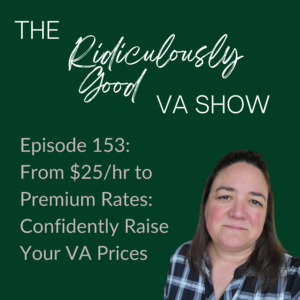Welcome to another episode of the podcast that teaches you how to be a ridiculously good virtual assistant.
Today I want to talk about raising your rates.
Today’s Quote: Price is what you pay. Value is what you get. – Warren Buffett
Click the play button above to tune in, or choose your favourite podcast player below:


Connect with Tracey D’Aviero, VA Coach and Trainer




Episode Notes:
Let’s talk about money. More specifically, your Virtual Assistant rates.
If you’re still charging the same hourly rate you started with, this episode is going to give you the confidence boost you need to raise your prices and own your value as a VA.
You’ve likely heard this quote before. Warren Buffett said, “Price is what you pay. Value is what you get.” And that mindset is exactly what we’re digging into today.
Let’s start with something that might be hard to hear.
When you undercharge, it hurts more than just your bank account. It affects how you show up. It chips away at your confidence. And it attracts the kind of VA clients who don’t really see the value in what you do.
When you price your VA services too low, it sends a message — not just to clients, but to yourself. That message says, “I’m not sure I’m worth more.”
And over time, that becomes a belief. A belief that you’re only capable of earning a certain amount. A belief that clients won’t pay more. A belief that you have to hustle harder just to stay afloat.
I tell you all the time that I started my VA business not charging enough. Lots of VAs I talk to these days still do not charge enough.
Not earning enough money makes you struggle. You can’t pay for tools that help you be more productive. You can’t pay to get help where you are stuck. Or you can’t pay yourself enough even if you work a full time week.
And once you set your rates too low, it’s hard to make the shift.
I get it. Raising your VA rates feels scary.
You worry about losing clients, about people saying no, about not being able to replace that income if you do lose a client.
But the truth is, undercharging is way worse in the long run than raising your rates.
So let’s talk about how you know it’s time.
You’re probably ready to raise your VA rates if your schedule is full but your bank account still feels tight.
Or if you are working long hours every day and you still don’t earn enough.
Or if your clients are paying the same amount they did a year ago.
Well I have news for you, you are a more skilled Virtual Assistant now than when you started. If you’re doing work faster and better than you did six months ago. If you’ve picked up new tools, new certifications, or simply gotten clearer about the results you help your clients get.
You don’t need to wait for some magical milestone before you’re “allowed” to raise your rates. The fact that you’re even asking the question is usually a sign you already know the answer.
I never really felt like I was succeeding until my first business coach made me double – yes, double – my rates overnight. I went from $25/hr to $50/hr.
And guess what? I got new VA clients who didn’t bat and eye at hiring me.
But here’s the mindset shift that makes the biggest difference for Virtual Assistants.
Raising your rates isn’t about charging more for the same thing. It’s about understanding that your clients aren’t paying for your time — they’re paying for the results you help them achieve. That’s the value.
Let me say that again. Clients pay for outcomes, not hours.
And the interesting thing is, if you charge your clients by the deliverable instead of by the hour, and if you can find ways to work more efficiently, you can give yourself a raise any time you like.
If you’re still thinking, “Well, it only takes me 30 minutes to do that,” you’re thinking like an employee. You’re thinking like someone who trades time for money.
But you’re not an employee. You’re a business owner. Your clients are paying for your expertise, your experience, your speed, your ideas, your resourcefulness. They are paying to get stuff done.
That’s what makes your work valuable. Not the number of minutes or hours it takes you to do it.
I used to charge my clients for every minute I worked. As I got faster at what I was doing, I earned less money!
Then I switched to billing in 25 minute increments. Guess what? Same damn thing.
It wasn’t until I set a billable rate for every task I did, and billed that amount to a client, that I could stop worrying about how long everything took, and instead started looking for more efficient ways to work, so I could do it faster and still charge the same amount.
It’s a different way of thinking about your work, and it uplevels the way you work by looking for ways to do things better, and you never get penalized for working faster.
Even if you don’t do that, raising your rates is important to the success of your VA business.
Knowing why you need to, and knowing how you can make all the difference in how confident you are about it.
So when it comes time to raise your rates, you want to approach it with clarity and confidence. That starts with communicating with your current clients.
Many VAs worry that raising rates will lead to losing the clients they’ve worked so hard to get. And while that’s possible, it’s not as common as you think — especially if you’ve been providing real value.
When you tell a client your rates are increasing, you don’t need to over-explain. You don’t need to justify it or apologize. Be professional, give them notice, and remind them of the value you bring. Most of the time, if the relationship is solid and your work has been valuable, they’ll accept the increase without much pushback.
When I raised mine – doubled them – I told my clients what their new rate was and when it would take effect.
Now did I double everyone? No but I got them as close to my new rate as possible.
Some left (fine!), some said sure (they knew they had a great deal up till then), and some I stepped up over a few months to make it less painful.
And with all of them we talked about what I was doing for them, and assessed whether it was still a priority. We chopped stuff out, we found ways to do things more efficiently. And some of their monthly billing stayed the same because I was doing less work each month. But I still got my raise.
Now let’s talk about quoting new clients. This is where a lot of VAs hesitate, because quoting a higher rate with someone you don’t know yet feels risky. You don’t want to scare them away. But here’s the thing — quoting low doesn’t guarantee the sale either. It just guarantees you’ll resent the work if you do get it.
When you quote higher from the start, you establish your value as a VA.
You set expectations. You communicate that you’re not just a helper, you’re a professional.
And it’s easier to negotiate down than up. If you quote $50 an hour and they want to negotiate, you can talk about it.
Not to negotiate a lower rate, but you can talk about their priorities as I did. And work with their budget.
Like I said, charging higher rates helps you pleven your communication along with your services.
If you start at $25 and realize you’re doing way more work than you expected, you can’t suddenly ask for more later.
Confidence in quoting comes from preparation. Know your numbers. Know how long things take you. Know what it costs to run your business. Know what kind of clients you want and what problems you solve for them.
Again with the help of my first business coach I documented all of my tasks and I knew how long it would take me to do each thing a client needed.
It was easy to give estimates on the phone because I was prepared to. And when you are confident and clear the client is too.
Their energy is reflected by the energy you put out.
You might be thinking, “Okay, I want to raise my rates, but how can I make sure my clients feel like they’re still getting their money’s worth?”
This is where adding value comes in — not by adding more hours, but by refining the experience. You can elevate your value by improving your processes, responding quickly, delivering consistent results, making suggestions, being proactive, or introducing tools that save time or money.
Value doesn’t always mean more effort. It often just means more intention.
Think about the way you package your services. Can you bundle things together in a way that makes your client’s life easier? Can you offer a VIP option for those who want faster turnaround or more personal access? Can you offer suggestions to improve their business beyond the tasks they assign you?
When you are really clear on how you help them you can suggest added value pieces that make them feel well supported too.
When you do all of that, your rates feel justified — not just to your client, but to you.
For me, I added reporting or data collection or sorting or organizing or production calls. Things that added to their support and enhances the things that I did for them already. Things that made sense.
Let’s circle back to the quote we started with. Warren Buffett said, “Price is what you pay. Value is what you get.”
Your VA clients are not just paying for tasks to get done.
They’re paying for peace of mind. They’re paying for trust. They’re paying to know that something important is off their plate and in capable hands. Your capable hands!
That’s what makes you worth more than $25 an hour. Way more. That’s what makes you worth premium rates.
Not just the tasks, but the transformation. The entire package of support you provide.
And the more you understand and communicate that value, the easier it becomes to raise your prices — and attract clients who are more than happy to pay them.
Once one VA client agrees to your higher rate it’s easier to talk money with the next one!
Do You Need Help?
I can help you through this whole process. It’s the only reason I’m here at all, is to help you become a ridiculously good Virtual Assistant.
Reach out to me on social media to chat about it.
And if you want to work with me, check out all of the ways you can do that, from free stuff to private coaching options at YourVAMentor.com/links
Thanks for tuning in this week, I’m Tracey D’Aviero The Confidence Coach for VAs – I’ll see you next time!